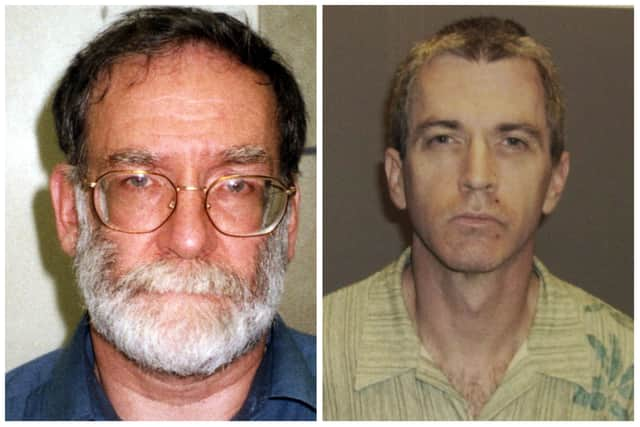Dr Harold Shipman: how many people did serial killer murder - links to Netflix show The Good Nurse explained


Harold Shipman is the UK’s most notorious serial killer - with the true number of people murdered by him unknown. In fact the GP - dubbed Dr Death, is considered one of the most prolific serial killers in recent history.
Shipman is to date the only British doctor convicted of murdering his patients - and his shocking crimes brought about change to the way doctors are overseen.
Advertisement
Hide AdAdvertisement
Hide AdSuspicions over Shipman were sparked in 1998, and police investigated however there was not enough evidence to bring charges at that point.
After the investigation Shipman went on to murder three more people - and his crimes eventually caught up with him in September 1998 when he was arrested.
But how many people did Shipman actually kill, and how was he caught? And why has the case drawn similarities with that of Charles Cullen and the Netflix drama The Good Nurse? This is what you need to know.
Who was Harold Shipman?
Born in 1946 he Shipman studied at Leeds School of Medicine, graduating in 1970. He began working at Pontefract General Infirmary and in 1974, started working as a GP at the Abraham Ormerod Medical Centre in Todmorden.
Advertisement
Hide AdAdvertisement
Hide AdHowever, a police investigation just a year after Shipman had become a GP revealed he was addicted to the drug pethidine and would obtain large quantities of it for personal use by befriending his elderly patients, visiting them at home and then forging prescriptions in their names.
Shipman was convicted and fined £600, losing his job in Todmorden. But the General Medical Council decided not to strike him off the medical register. He went on to work as a GP in Hyde.


How many people did Shipman kill?
Shipman whose crimes took place between 1975 and 1998 was convicted of killing 15 people while working in Hyde, Greater Manchester. However the Shipman Inquiry identified 218 victims, and estimated the tally could actually be as many as 260.
A large number of those Shipman killed were elderly women - though his youngest identified victim was a 41 year old man. Shipman was jailed for life in 2000, four years later at the age of 57 years old he committed suicide in his cell. The people he was convicted of murdering were:
- Marie West
- Irene Turner
- Lizzie Adams
- Jean Lilley
- Ivy Lomas
- Muriel Grimshaw
- Marie Quinn
- Kathleen Wagstaff
- Bianka Pomfret
- Norah Nuttall
- Pamela Hillier
- Maureen Ward
- Winifred Mellor
- Joan Melia
- Kathleen Grundy


How was he caught?
Advertisement
Hide AdAdvertisement
Hide AdAn initial investigation took place in 1998 after concerns were raised about a high death rate among Shipman’s patients and a large number of cremation forms that he had countersigned, while another GP also informed the Medical Defence Union. However, police were unable to find sufficient evidence and closed the investigation.
Months later a taxi driver informed police he believed Shipman had murdered 21 patients after spotting the high death rate among elderly female patients he had taken to his surgery, despite them seeming in good health when they arrived.
Shipman’s last victim, Kathleen Grundy, was found dead at her home in June 1998 with Shipman being the last person to see her alive and recording cause of death as old age.
Her daughter Angela Woodruff, who was a lawyer, was informed by a solicitor that a suspicious looking will had been made seemingly by her mother, excluding Woodruff and her children but leaving £386,000 to Shipman.
Advertisement
Hide AdAdvertisement
Hide AdWoodruff went to the police, who began an investigation, it was found that Grundy’s body contained traces of diamorphine. Shipman claimed she was an addict and pointed to comments he made in his computerised medical records. However, on examination they were found to be false. He was also found to own a Brother typewriter - the same which had been used to type the forged will.
Police looked into other deaths he had registered and found a pattern where he had given them lethal does of diamorphine, the clinical name for heroin, and then falsified their medical records to make it look like they were in poor health.
Shipman had stockpiled vast amounts of the drug by falsely prescribing it as a painkiller for dying patients. The GP would usually call on his victims at their homes, often on a pretext, before dispensing the deadly injections.
Former detective chief superintendent Chris Gregg who quizzed Shipman told BBC Two’s The Shipman FIles: “I think Shipman sought opportunity, it was about opportunity and risk - what are the chances of me being caught? He knew if it was an elderly person he could write off their death by way of a simple death certification and get away with it, as he did.”
Advertisement
Hide AdAdvertisement
Hide AdHe added: “I am convinced on every visit he would have been on he would have had the means to do it and the circumstances would have had to be right for him. Each time he did it he would have become more confident and comfortable.”
What is the connection with The Good Nurse?
The Netflix drama is based on the true story of how nurse Charles Cullen - thought to be the most prolific serial killer in the US, was caught.
He murdered dozens, though it’s suspected he could have killed hundreds of patients of the course of 16 years between 1988 to 2003.
Twenty nine people are confirmed to have been killed by him - and he has confessed to killing as many as 40. The case has drawn comparisons with Shipman - who like Cullen also killed his victims by way of a lethal overdose. Cullen was sentenced to 18 consecutive life sentences.
